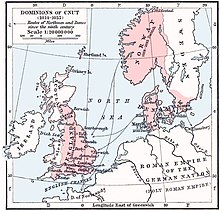Danish mark
An area in today's Schleswig-Holstein north of the Eider and south of the Danewerk near Schleswig is referred to as the Danish Mark or Mark Schleswig . It is said to have been an early medieval border mark of the Franconian Empire against the Danish kings. The term Danish Mark itself is unknown in medieval sources. After the Frankish imperial annals in 828, however, the Danish kings and their troops penetrated “into the march” (ad marcam) . In the yearbooks of Fulda the "Guardians of the Danish border" (custodes Danici limitis) appear in 852 .
Carolingian
It is often stated that Charlemagne set up a Danish mark around 810 to meet the Danes' claims to rule on the part of their ambitious King Gudfred over the then Saxon areas north of the Elbe, which Karl had recently subjugated. How far and how long there was a Carolingian border mark is not certain.
In Wigmodien (Elbe-Weser triangle between the mouths of the Weser and Elbe) and in Trans- or Northern Albingia (north of the Lower Elbe) the Saxons had resisted Charlemagne the longest. Many of the repeatedly rebellious nobles from the North Elbe were deported to the interior of the Franconian Empire in 795 and in particular in 804 and their goods were initially given to Slavic Abodrites as a buffer between the Franconian and Danish Empire. After the Danes had made tribute to the Abodrites in 808, the Franks pushed their way across the Elbe again, claimed the Saxon territories there and, following the Frankish imperial annals, began building Esesfeld Castle on March 15, 809 . Since the Danish King Gudfred was murdered in 810 as a result of internal power struggles, his successor Hemming made a peace with the Frankish Empire in 811 on the Eider (near today's Rendsburg ), which laid down the river as a border.
However, in the Franconian Reichsannalen for the year 828 it is reported that the Danes penetrated the "Mark" and crossed the Eider, which in this formulation implies the possibility that a Carolingian Mark was now (?) North of the Eider. The background could have been fights that have been attested to in the years after Charles's death in 814: in 817 Danes and Abodrites besieged the Esesfeld fortress together, but unsuccessfully. Franconian border counts in northern Albingia are attested in 822, but their influence probably did not go far beyond Esesfeld Castle. The Franks were most likely unable to hold the castle, so that the Delbende was built in 822 and then the Hammaburg on the Elbe around 825 . Since even the Saxon areas between the Elbe and Eider were apparently not firmly under Carolingian control, it is unlikely that the imperial influence extended north of the Eider and that there was a mark there.
Ottonen
The first Ottonian king of Eastern Franconia, Henry I , achieved a significant victory over the Danes in 934 - according to other sources in 931 or 936. In this context, Adam von Bremen reports for the first time about the appointment of a margrave in the important trading place Haithabu on the Schlei and the settlement of Saxony (I c. 59). It is therefore generally assumed that Heinrich I added the area between the Eider and Schlei to his empire as a mark. His son Otto I then founded the diocese of Schleswig in 948 . In 974, rebellious Danes killed the margrave, but were pushed back after a while by Duke Bernhard I and Count Heinrich I of Harsefeld / Stade. In connection with the Slav uprisings, the Danes succeeded in 983 in moving the southern border of their empire back to the Eider for a while. Initially, however, the border area remained contested.
In 1025 King Knut's daughter Gunhild became the son of Emperor Conrad II , the future Emperor Heinrich III. , promised. In return, Knut the Great was recognized by the emperor as ruler over southern Jutland up to the Eider (the wedding itself did not take place until 1036). This marked the end of the Schleswig mark.
The Danish total administrative area of Fræzlæt, which was later established, was almost identical in size to that of the Danish mark .
literature
source
- Einhard: Vita Caroli Magni / The life of Charlemagne . Reclam, Stuttgart 1997.
Modern literature
- Josef Fleckenstein: Charlemagne . Göttingen 1967.
- Dieter Hägermann : Charlemagne. Rowohlt, Reinbek near Hamburg 2003, ISBN 3-499-50653-X
- Thomas Riis: From the state “synnan aa” to the Duchy of Schleswig . In: Klaus Düwel, Edith Marold , Christine Zimmermann: From Thorsberg to Schleswig. Language and writing of a border area over the course of a millennium . Berlin / New York 2001, pp. 53–60
- Thomas Klapheck: Saint Ansgar and the Carolingian Northern Mission . Diss. Phil. Oldenburg, Verlag Hahnsche Buchhandlung Hannover 2008, chapter 2.4.3 The development of Transalbingia up to the time of Ansgar , pp. 88–95
Web links
Individual evidence
- ↑ Dieter Hägermann: Charlemagne. Rowohlt, Reinbek bei Hamburg 2003, p. 44.


